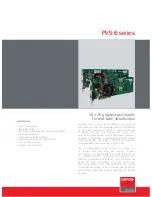
Peritek
5-50
Programming On-board Devices and Memories
5.8 BT459 - Color Map Controller for the VCD-V
Note
This section describes the features of the BT459. Some of these features
are not directly used or supported in the Peritek
PX Windows
including
overlays (but this will change with X11R6).
On the high resolution VCD-V (e.g. VCD-V/X12), the composite video
output is generated by the Brooktree BT459 high performance monolithic
color map/cursor controller. The BT459 latches four pixels of 8-bit
primary screen data plus four bits for overlay. The data is synchronized
internally through another register, and then fed pixel-by-pixel through the
chip.
The BT459 provides composite sync generation, the color map lookup
tables, cursor bit map and position control, primary and overlay plane
blinking and blanking, and video output DACs. In addition to the
customary 256 word translation map for the 8-bit primary graphics plane,
it contains 15 additional table entries for the 4-bit graphics overlay planes
and 3 for the 2-bit cursor. Each table entry is a 24 bit value (8 bits each for
R, G, and B). It occupies four register locations in the VCD Device Buffer.
The registers use only the low 8 bits of each word. The BT459 is
controlled through an 8 bit I/O port. It functions exactly the same way as
the BT463, described in the Section 5.6.
The BT459 has a two bit graphics cursor. It contains a 64 x 64 x 2 bit map,
position match registers, and counters triggered by the dot clock and
referenced to horizontal and vertical sync. The match registers compare a
programmed value (corresponding to an X-Y position on the screen) to the
counters. When coincidence occurs, the cursor output become active and
select one of the three cursor colors. By setting the correct internal control
bits, the BT459 can supply a bit-map cursor and/or a cross-hair cursor. The
display window for the cross-hair is programmable.
A four bit horizontal zoom control is taken from the MACH110 VCDV6
and applied to the load inputs of a GAL16V8-7 (VCDV9) which functions
as a high speed counter to yield an integer zoom function at 125 MHz.
VCDV9 also generates a differential TTL clock and load for the BT459.
Using the clock from the GAL, VCDV6 generates VCLK for the 34020
and VRAM shift clocks.
Содержание VCD-V
Страница 2: ...Peritek ...
Страница 3: ...Peritek ...
Страница 5: ...Peritek ...
Страница 6: ...Peritek ...
Страница 10: ...Peritek ...
Страница 41: ...Peritek 2 10 Installing Your Peritek Graphics Board Figure 2 2 Jumper Locations for the VCT V and VCU V ...
Страница 42: ...Peritek Installing Your Peritek Graphics Board 2 11 Figure 2 3 Jumper Locations for the VCD V ...
Страница 94: ...Peritek Theory of Operation 4 15 Figure 4 1 VCD V Block Diagram ...
Страница 95: ...Peritek 4 16 Theory of Operation Figure 4 2 VCU V Block Diagram ...
Страница 96: ...Peritek Theory of Operation 4 17 Figure 4 3 VCT V Block Diagram ...
















































